Your cart is currently empty!
2019 Ottawa Garden Survey – Executive Summary
This a summary of the most frequent comments received from 81 questionnaire responses received by Gardens Ottawa between February 8th and March 31st, 2019.
Your cart is currently empty!
These seven easy outdoor plants will set you on your way to sprucing up that backyard in no time. And they require very little care. Whether you’re looking to add a splash of colour for a season or for your greenery to return year after year, there’s something for everyone when it comes to outdoor plants.
When it comes to outdoor plants, the choices are countless. Because of this, a new gardener can easily become overwhelmed. In order to narrow down your options, the first thing you want to do is assess your planting location.
A few good questions to ask yourself are:
By answering these types of questions, you’ll get a better feel for the types of plants best suited for your situation.
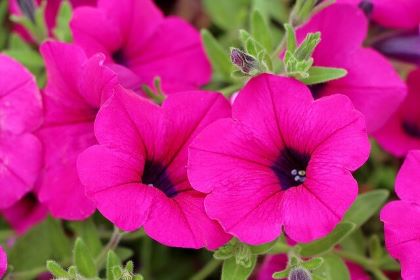
Petunias are my go to plants when I want a bit of colour. Talk about an easy outdoor plant! These guys are hardy annuals, simple to care for and make a great choice for the novice gardener.
They come in a variety of striking colours – pink, blue, white, purple, striped. And, not only are the current colours great, almost every year growers come out with new and exciting shades.
You’ll find petunias are popular plants for borders, filling in spaces in flower beds, and for containers. They’re prolific bloomers that flower all season long.
However, there are some types that need deadheading (removing the dying flower) to keep them strong. This is especially true for the older varieties. Deadheading is an easy process, but it’s something you should keep in mind when choosing your petunias.
Petunias like the sun, though extreme heat can cause them to stop flowering until the temperature drops. You can plant them in partial shade, but keep in mind they might not bloom as abundantly.
If planted in the ground, a weekly, deep watering should be sufficient. Those planted in containers will need more frequently watering, depending on the heat and size of the container.
Petunias don’t like to be dry for long periods of time, but they also don’t like their feet soggy. If you find your petunias are becoming “leggy” – meaning lots of stems but not so many flowers, it could be a sign of too much water.
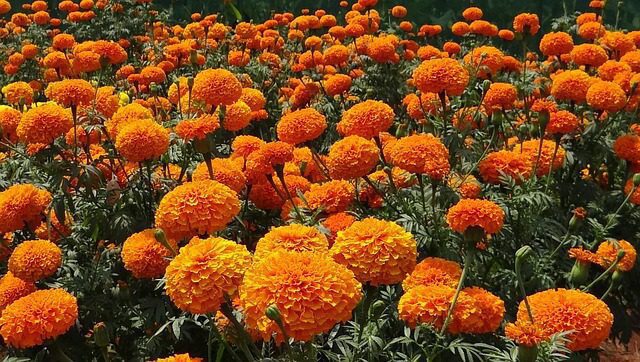
With their bright, cheerful reds, oranges, and yellows, marigolds are another great option for both containers and in-ground gardens. They are easy to grow with sticking flowers that bloom all summer long. Not only that, they can tolerate high heat and weak soil conditions.
Marigolds don’t require deadheading, but once your marigolds have established themselves, pinching off the tops of the plants and removing the dying blossoms will encourage them to bloom more and grow bushier. They like plenty of circulation, so if planting in a pot, make sure you don’t crowd them in.
Fun Fact: Marigolds make great companion plants because they support the health of most garden plants and repel insects and pests, such as deer and beetles.
Though you can plant them in partial shade, marigolds prefer the sun and really need at least 6 hours of full sun to bloom properly.
When watering, water well, then allow the soil to dry out between the next two waterings. You should water at the base of the plant instead of overhead, which can sometimes lead to powdery mildew on the leaves.

I love hostas. They make great additions to all kinds of gardens and are a very easy outdoor plant to have.
Hostas are perennials, meaning they come back year after year. These hardy, long-lived plants come in different sizes and heights and have different shades of attractive foliage. During the summer, hostas produce fragrant flowers that are appealing to hummingbirds and bees.
One of the nice features of a hosta is that they prefer a bit of shade, which can make them ideal for those shadier, hard-to-fill spots.
However, the amount of shade they tolerate will depend on the leaf colour. Leaf colour can range from solid greens, so deep they’re called blue, to creamy whites and greens of the variegated varieties.
When placing your hosta, a good rule of thumb to remember is that lighter colours and variegated varieties will need a bit more sun. On the other hand, the darker foliage does best in moderate shade. Regardless of the colour, though, hostas do not do well in strong, direct sunlight.
The soil should be kept moist but not sopping wet. Hostas can tolerate some drought, especially mature plants, and they will survive with just normal rainfall. However, to keep them looking lush and growing well, you’ll want to water them, especially in sunnier spots.
If the leaves are wilting and turning brown, that may be a sign that the soil is too dry. As with marigolds, always water hostas from the base of the foliage rather than overhead.
One thing to note about hostas and to keep in mind when planting is that slugs, snails, deer, and rabbits are also hosta lovers.
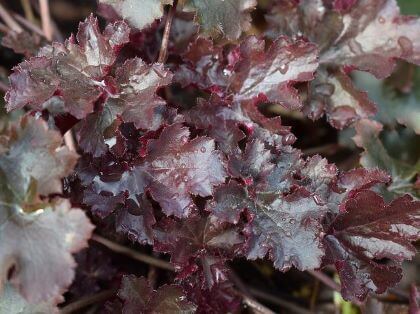
Coral bells are known for their unusual foliage, which can include colours such as reds, greens, purples, and silver. Their tiny, bell-shaped flowers grow on long stalks and blossom spring through summer. The little flowers, rising about their low-growing leaf mound, can make quite a striking addition to any garden.
Besides being excellent ground cover plants, coral bells are also well-suited to borders and paths. And once established, they require very little maintenance to return year after year.
Most coral bells are cold-hardy, though they can tolerate the heat and humidity in warmer zones. They like partial shade but will take a bit more sun in colder climes.
Although they will tolerate a week or two without water, to really help them flourish, try keeping them moderately moist. And make sure to use well-draining soil.
Few pests or diseases bother these beauties. They are also deer-resistant, and as an added bonus, hummingbirds often visit the delicate flowers. All of this is to say that coral bells are wonderful, easy outdoor plants for beginner gardeners.
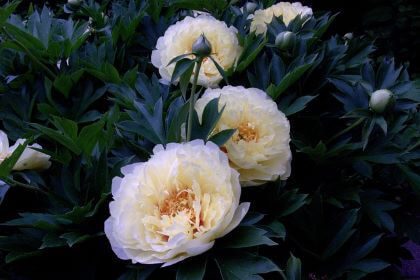
The peony is an absolute beauty. Blooming from spring to summer, these lush perennials can thrive for years. The peony’s bushy leaves are glossy and green and last all summer before turning colour in the fall. And once fully established, which can take a few years, peonies require little maintenance.
However, although they are not fussy plants, they don’t like to be moved, so make sure to pick a spot you’ll want them to stay in.
Peonies are sun lovers and bloom best when they get 6 – 8 hours a day of sunlight. The large flowers can make them heavy, so it’s best to provide some type of plant support to help keep them upright.
On the bush, once the flower is spent, you can deadhead it, cutting the stem back to the closest strong leaf. The blooms also make wonderful flowers for vases and can be harvested for this purpose. Just check for insects before bringing them in the house (I learned that the hard way!).
Peonies prefer a rich, moist, well-draining soil. You should water your peony deeply, then let the soil almost dry out before watering again. For mature plants, usually watering every 10 – 14 days is adequate. However, young plants just starting out will require more.
And don’t plant these fellas too close to other plants that will compete for food, light and moisture. They won’t like it. Good air circulation makes them happy. Besides, you don’t want to detract from their beautiful blooms.
One thing to note is that peonies like colder winters and do best in zones 3 – 7. https://www.richters.com/show.cgi?page=InfoSheets/NA.html There are a few varieties you can try if you live in zone 8, but overall, they will not grow successfully in the deep south.
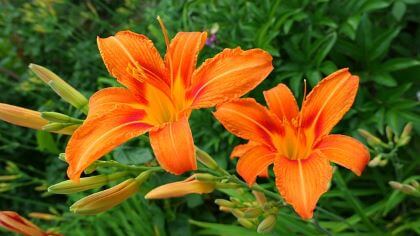
Most people are familiar with this hardy perennial, having seen them in gardens, on borders or even growing in ditches along the roadside.
Daylilies are easy outdoor plants made for beginners and brown thumbs. With next to no attention, they’ll produce striking flowers in a multitude of colours. Not only that, they tolerate a wide variety of soil conditions, are drought-tolerant, can thrive in cold and warm climates, and bloom yearly.
Fun Fact: A daylily is called a daylily because the flower usually only lasts 24 hours.
Daylilies do best when planted in full sun—at least 6 hours/day. Although dark-coloured varieties might need a bit of afternoon shade to retain their color,.
Plant your daylilies in moist, well-draining soil. In the first year of planting, you’ll want to water more frequently. Maybe once or twice a week, depending on rainfall. However, once established, you can just let nature provide the water.
They’re drought-tolerant, so they’ll be fine if your area is having a bit of a dry spell. But if the drought is lasting longer than a month, then you’ll need to provide some water. When you water, they benefit from deep watering sprayed beneath the plant rather than overhead.
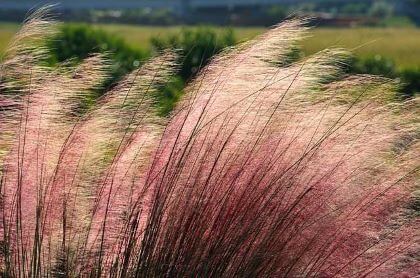
Ornamental grasses can range in height from 12 in. to 12 ft. Furthermore, shapes can range from mounded spikes to tall, billowy stalks. Because of their varying heights and different textures and colours, you’ll find grasses will fit into any garden theme.
And not only are they great garden additions, they are low-maintenance and perfect for both the new gardener and brown thumb.
Different grasses experience different growth periods depending on whether they like a cool season or a warm season. With all these options, it’s easy to choose the grass best suited for your garden’s needs.
Newly planted grasses should be kept well watered, but once established, most varieties are drought-tolerant and don’t require much additional water, unless your area is experiencing an extended dry spell.
Ornamental grasses are not super picky about soil, other than wanting good drainage. No ornamental grass likes its feet wet, even the varieties that like it a little moister.
Most grasses like full sunlight, but you can find some varieties that will tolerate partial shade. When it comes to choosing grass, it’s best to check locally to see what variety is suited to your region.
At some point in the spring, you’ll need to cut back your grass to get rid of last year’s dead stalks. The exact timing of this will depend on the type of grass you’ve planted.
Most grasses are deer-resistant and not overly susceptible to pests. One more reason to consider an ornamental grass.
Any of these seven easy outdoor plants would make a wonderful addition to your garden, whether you’re looking just to the season or for years to come. They’re ideal for beginners and a great way to try your hand with gardening.
This a summary of the most frequent comments received from 81 questionnaire responses received by Gardens Ottawa between February 8th and March 31st, 2019.
Learn how Maranta leuconeura, also known as the Prayer Plant, showcases a distinctive leaf mechanism that sets it apart from other plants.
Penstemon digitalis bell-shaped flowers are nectar-rich, which makes them one of the best plants to attract hummingbirds.
from Old Ottawa South Garden Club Join the Old Ottawa South Garden Club for a workshop on Ikebana—a traditional Japanese art of flower arrangement by Elizabeth Armstrong, Second Associate Master in the Ohara School. Learn about its history and create your own arrangement with help from Elizabeth and Patty McGaughlin. Next meeting on April 9th to learn about easy-care, hardy perennials and lazier gardener methods.
Get accurate weather data, manage watering, monitor plant health, control pests and diseases, plan for seasons, understand microclimates, and make data-driven gardening decisions with a weather station.
See the unique qualities of blue-stemmed goldenrod—attracts pollinators & is deer & rabbit-resistant. Enjoy its bright yellow flowers & bluish stems in native plant gardens, open woodland gardens, borders, wild gardens & more. Prune & divide in spring or fall.
GardeningCalendar.ca gets some funding from advertisers. If you click on links and advertisements at no cost to you, the site may receive a small commission that helps fund its operation.
© 2025 J&S Calendars Ltd.
Leave a Reply
You must be logged in to post a comment.